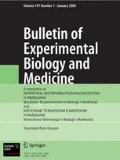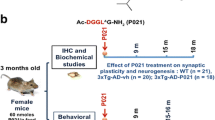Neuroprotective peptides are promising candidate molecules for the treatment of Alzheimer’s disease (AD). Oral application of KED (Lys-Glu-Asp) improved memory and attention in elderly individuals with functional CNS disorders. Peptide KED also restores synaptic plasticity in in vitro model of AD. This review is focused on the analysis of the influence of KED peptide on the expression of genes and synthesis of proteins regulating apoptosis, aging, neurogenesis, and involved in AD pathogenesis. Analysis of published reports and our experimental findings suggests that KED regulates the expression of genes of cell aging and apoptosis (р16, р21), genes (NES, GAP43) and proteins (nestin, GAP43) of the neuronal differentiation, and genes involved in AD pathogenesis (SUMO, APOE, and IGF1). The study the effectiveness of neuroprotective peptide KED in animal models of AD seems to be very important.
Similar content being viewed by others
References
Balashova SN, Zhernakov GL, Dudkov AV. Application of peptide bioregulators by old people suffering from psychoemotional disorders. Uspekhi Gerontol. 2008;21(3):448-452. Russian.
Zhurkovich IK, Kovrov NG, Ryzhak GA, Mironova ES, Khavinson VKh. Identification of short peptides as part of polypeptide complexes isolated from animal organs. Uspekhi Sovermen. Biol. 2020;140(2):140-148. doi: 10.31857/S004213242002012X. Russian.
Kraskovskaya NA, Kukanova EO, Lin’kova NS, Popugaeva EA, Khavinson VK. Tripeptides Restore the Number of Neuronal Spines under Conditions of In Vitro Modeled Alzheimer’s Disease. Bull. Exp. Biol. Med. 2017;163(4):550-553. doi: https://doi.org/10.1007/s10517-017-3847-2
Khavinson VK, Lin’kova NS, Tarnovskaya SI. Short Peptides Regulate Gene Expression. Bull. Exp. Biol. Med. 2016;162(2):288-292. doi: https://doi.org/10.1007/s10517-016-3596-7
Shilovsky GA, Ashapkin VV, Linkova NS, Khavinson VK, Vanyushin BF. Expression of KLF, PTEN, SUMO1, APOE, SOD2, and SHC1 genes in differently “aged” quiescent cells: a model for testing of some geroprotectors. Klin. Gerontol. 2018;24(9-10):80-82. Russian.
Ashapkin V, Khavinson V, Shilovsky G, Linkova N, Vanuyshin B. Gene expression in human mesenchymal stem cell aging cultures: modulation by short peptides. Mol. Biol. Rep. 2020;47(6):4323-4329. doi: https://doi.org/10.1007/s11033-020-05506-3
Caputi S, Trubiani O, Sinjari B, Trofimova S, Diomede F, Linkova N, Diatlova A, Khavinson V. Effect of short peptides on neuronal differentiation of stem cells. Int. J. Immunopathol. Pharmacol. 2019;33. doi: https://doi.org/10.1177/2058738419828613
Cho SJ, Yun SM, Jo C, Lee DH, Choi KJ, Song JC, Park SI, Kim YJ, Koh YH. SUMO1 promotes Aβ production via the modulation of autophagy. Autophagy. 2015;11(1):100-112. doi: https://doi.org/10.4161/15548627.2014.984283
Dinda B, Dinda M, Kulsi G, Chakraborty A, Dinda S. Therapeutic potentials of plant iridoids in Alzheimer’s and Parkinson’s diseases: a review. Eur. J. Med. Chem. 2019;169:185-199. doi: https://doi.org/10.1016/j.ejmech.2019.03.009
Grösgen S, Grimm MO, Friess P, Hartmann T. Role of amyloid beta in lipid homeostasis. Biochim. Biophys. Acta. 2010;1801(8):966-974. doi: https://doi.org/10.1016/j.bbalip.2010.05.002
Hoveizi E, Mohammadi T, Moazedi A.A, Zamani N, Eskandary A. Transplanted neural-like cells improve memory and Alzheimer-like pathology in a rat model. Cytotherapy. 2018;20(7):964-973. doi: https://doi.org/10.1016/j.jcyt.2018.03.036
Khavinson V, Linkova N, Diatlova A, Trofimova S. Peptide regulation of cell differentiation. Stem Cell Rev. Rep. 2020;16(1):118-125. doi: https://doi.org/10.1007/s12015-019-09938-8
Krishnasamy S, Weng YC, Thammisetty SS, Phaneuf D, Lalancette-Hebert M, Kriz J. Molecular imaging of nestin in neuroinflammatory conditions reveals marked signal induction in activated microglia. J. Neuroinflammation. 2017;14(1):45. doi: https://doi.org/10.1186/s12974-017-0816-7
Li J, Han Y, Li M, Nie C. Curcumin promotes proliferation of adult neural stem cells and the birth of neurons in Alzheimer’s disease mice via Notch signaling pathway. Cell Reprogram. 2019;21(3):152-161. doi: https://doi.org/10.1089/cell.2018.0027
Matsuzaki S, Lee L, Knock E, Srikumar T, Sakurai M, Hazrati LN, Katayama T, Staniszewski A, Raught B, Arancio O, Fraser PE. SUMO1 affects synaptic function, spine density and memory. Sci. Rep. 2015;5:10730. doi: https://doi.org/10.1038/srep10730
Niculescu AB, Le-Niculescu H, Roseberry K, Wang S, Hart J, Kaur A, Robertson H, Jones T, Strasburger A, Williams A, Kurian SM, Lamb B, Shekhar A, Lahiri DK, Saykin AJ. Blood biomarkers for memory: toward early detection of risk for Alzheimer disease, pharmacogenomics, and repurposed drugs. Mol. Psychiatry. 2020;25(8):1651-1672. doi: https://doi.org/10.1038/s41380-019-0602-2
Nisticò R, Ferraina C, Marconi V, Blandini F, Negri L, Egebjerg J, Feligioni M. Age-related changes of protein SUMOylation balance in the AβPP Tg2576 mouse model of Alzheimer’s disease. Front. Pharmacol. 2014;5:63. doi: https://doi.org/10.3389/fphar.2014.00063
Quick Q, Paul M, Skalli O. Roles and potential clinical applications of intermediate filament proteins in brain tumors. Semin. Pediatr. Neurol. 2015;22(1):40-48. doi: https://doi.org/10.1016/j.spen.2014.12.005.
Rosskothen-Kuhl N, Illing RB. Gap43 Transcription modulation in the adult brain depends on sensory activity and synaptic cooperation. PLoS One. 2014;9(3):e92624. doi: https://doi.org/10.1371/journal.pone.0092624
Sandelius Å, Portelius E, Källén Å, Zetterberg H, Rot U, Olsson B, Toledo JB, Shaw LM, Lee VMY, Irwin DJ, Grossman M, Weintraub D, Chen-Plotkin A, Wolk DA, McCluskey L, Elman L, Kostanjevecki V, Vandijck M, McBride J, Trojanowski JQ, Blennow K. Elevated CSF GAP-43 is Alzheimer’s disease specific and associated with tau and amyloid pathology. Alzheimers Dement. 2019;15(1):55-64. doi: https://doi.org/10.1016/j.jalz.2018.08.006
Sinjari B, Diomede F, Khavinson V, Mironova E, Linkova N, Trofimova S, Trubiani O, Caputi S. Short peptides protect oral stem cells from ageing. Stem Cell Rev. Rep. 2020;16(1):159-166. doi: https://doi.org/10.1007/s12015-019-09921-3
Sun CK, Zhou D, Zhang Z, He L, Zhang F, Wang X, Yuan J, Chen Q, Wu LG, Yang Q. Senescence impairs direct conversion of human somatic cells to neurons. Nat. Commun. 2014;5:4112. doi: https://doi.org/10.1038/ncomms5112
Vazquez-Villaseñor I, Garwood CJ, Heath PR, Simpson JE, Ince PG, Wharton SB. Expression of p16 and p21 in the frontal association cortex of ALS/MND brains suggests neuronal cell cycle dysregulation and astrocyte senescence in early stages of the disease. Neuropathol. Appl. Neurobiol. 2020;46(2):171-185. doi: https://doi.org/10.1111/nan.12559
Wei Z, Chen XC, Song Y, Pan XD, Dai XM, Zhang J, Cui XL, Wu XL, Zhu YG. Amyloid β protein aggravates neuronal senescence and cognitive deficits in 5XFAD mouse model of Alzheimer’s disease. Chin. Med. J. (Engl). 2016;129(15):1835-1844. doi: 10.4103/0366-6999.186646
Yan S, Li P, Wang Y, Yu W, Qin A, Liu M, Xiang A.P, Zhang W, Li W. Nestin regulates neural stem cell migration via controlling the cell contractility. Int. J. Biochem. Cell Biol. 2016;78:349-360. doi: https://doi.org/10.1016/j.biocel.2016.07.034
Zeng Q, Zheng M, Zhang T, He G. Hippocampal neurogenesis in the APP/PS1/nestin-GFP triple transgenic mouse model of Alzheimer’s disease. Neuroscience. 2016;314:64-74. doi: https://doi.org/10.1016/j.neuroscience.2015.11.054
Zhao JC, Zhang LX, Zhang Y, Shen YF. The differential regulation of Gap43 gene in the neuronal differentiation of P19 cells. J. Cell. Physiol. 2012;227(6):2645-2653. doi: https://doi.org/10.1002/jcp.23006
Zheng P, Tong W. IGF-1: an endogenous link between traumatic brain injury and Alzheimer disease? J. Neurosurg. Sci. 2017;61(4):416-421. doi: 10.23736/S0390-5616.16.03431-7
Author information
Authors and Affiliations
Corresponding author
Additional information
Translated from Byulleten’ Eksperimental’noi Biologii i Meditsiny, Vol. 171, No. 2, pp. 150-154, February, 2021
Rights and permissions
About this article
Cite this article
Khavinson, V.K., Lin’kova, N.S. & Umnov, R.S. Peptide KED: Molecular-Genetic Aspects of Neurogenesis Regulation in Alzheimer’s Disease. Bull Exp Biol Med 171, 190–193 (2021). https://doi.org/10.1007/s10517-021-05192-6
Received:
Published:
Issue Date:
DOI: https://doi.org/10.1007/s10517-021-05192-6




